
- Category: grade
- Growth type: indeterminate
- Appointment: fresh consumption, for pickling and preserving, for juice
- Ripening period: early
- Ripening time, days: 87-90
- Growing conditions: for greenhouses
- Transportability: Yes
- Bush size: tall
- Bush height, cm: up to 250
- Ripe fruit color: raspberry
Powerful tomatoes with large fruits will inspire even the most skeptical gardeners. But the Heart of Italy, for example, will please people only with a careful study of the main features of this culture. And you will also have to pay attention to how exactly to grow it.
Description of the variety
This plant is characterized by an indeterminate developmental system. It is mainly cultivated in greenhouses. The bushes of the Heart of Italy can rise to a height of 2.5 m. They are spreading and branchy. For 1 bunch 4, 5 or 6 berries are formed.
The main qualities of the fruit
When ripe, the berries of this variety have a raspberry color. They are large and weigh on average 200-300 g. It is mentioned that some weighty specimens weigh 0.5-0.6 kg. The shape of the fetus is similar to a stereotypical heart. It was for geometric reasons that the variety was named.
Taste characteristics
The pulp of such a plant is fleshy. The peel is strong, but does not have any important effect on the taste. The flavoring ensemble whimsically and, moreover, harmoniously combines:
sweet note;
gentle splash;
characteristic sourness.
Ripening and fruiting
The heart of Italy is one of the earliest tomatoes. With ordinary development, it is necessary to wait for the harvest in 87-90 days, after the very first shoots come out. Further fruiting should last a very impressive time - but here you will have to take into account the influence of weather and agricultural technology.
Yield
The collection for 1 "square" of the garden ranges from 8 to 11 kg. This clearly shows the importance of weather conditions. But also the relevance of good agronomic work is directly derived from this.
The timing of planting seedlings and planting in the ground
It is necessary to sow seeds in prepared containers with soil 45-60 days before the expected date of planting. She herself is determined individually. They take into account not only the peculiarities of the region, but also the actually developing weather, and the condition of the seedlings. Of course, the date will have to be flexibly adapted to the changing environment. Usually, the seedlings are ready for transfer to a permanent place in May, although sometimes this procedure has to be postponed to June.

Growing tomato seedlings is an extremely important process, because it largely depends on whether the gardener will be able to harvest at all. All aspects must be taken into account, from seedbed preparation to planting in the ground.
Landing scheme
A gap of 500-600 mm is left between the tomato holes. For 1 sq. m is allowed to place a maximum of 3 bushes. With their greater concentration, problems will be almost inevitable.

Growing and care
The bushes of the Heart of Italy must be tied up and shaped. Mostly they are led in 1 stem. However, some farmers may prefer the 2-stem system as well. It is necessary to water the bushes 3 times a week. Every 10 days of planting, they are stepson and shaped.
At the stage of seedling development, it is very important:
backlighting with phytolamps;
feeding with complex formulations;
picking as soon as it is ready;
hardening.
Top dressing of the bushes themselves in the beds is carried out 2-3 times during the growing season. Complex mineral fertilizers are also used for this purpose. If the cold comes early, unripe berries are better collected and left to ripen indoors. Resistance to the main part of diseases is quite high, but one should not rely on it too much. In cool, but not too cold, areas it is potentially possible to leave this crop without shelter; at the same time, one must always remember about the high sensitivity to frost.
Since this is a classic variety, not a hybrid, it is perfectly acceptable to choose seeds from the fruits of the previous harvest. Due to the powerful development of the bushes, a trellis can be considered the best option. Organic dressings work well, but minerals still play the main role. Reviews of the culture are positive. Tomato Heart of Italy will delight even in places with unstable, sometimes cold, summer; however, there are also tastier varieties.




A plant needs different micronutrients at each stage of growth. All fertilizers can be divided into two groups: mineral and organic. Folk remedies are often used: iodine, yeast, bird droppings, eggshells.
It is important to observe the rate and period of feeding. This also applies to folk remedies and organic fertilizers.



























































































